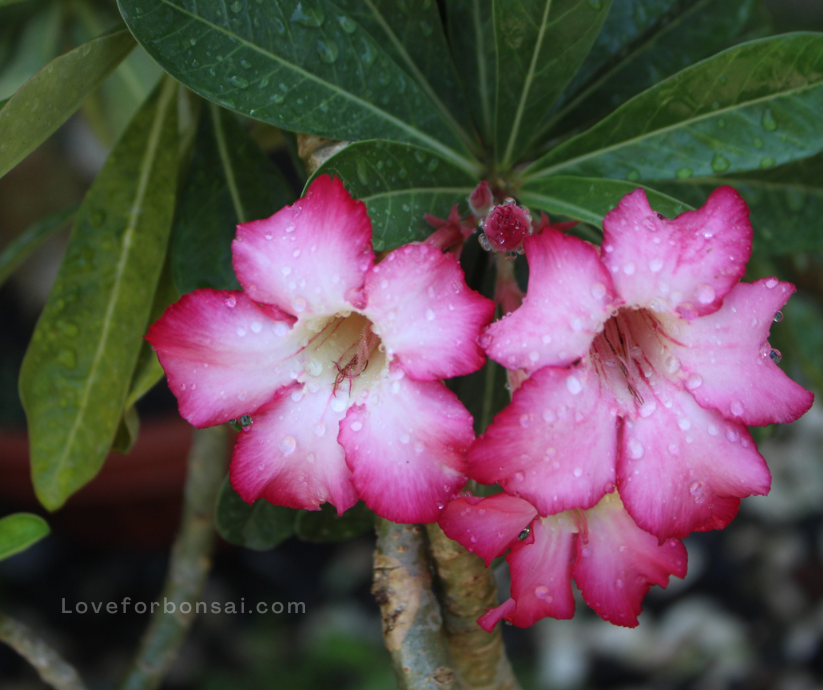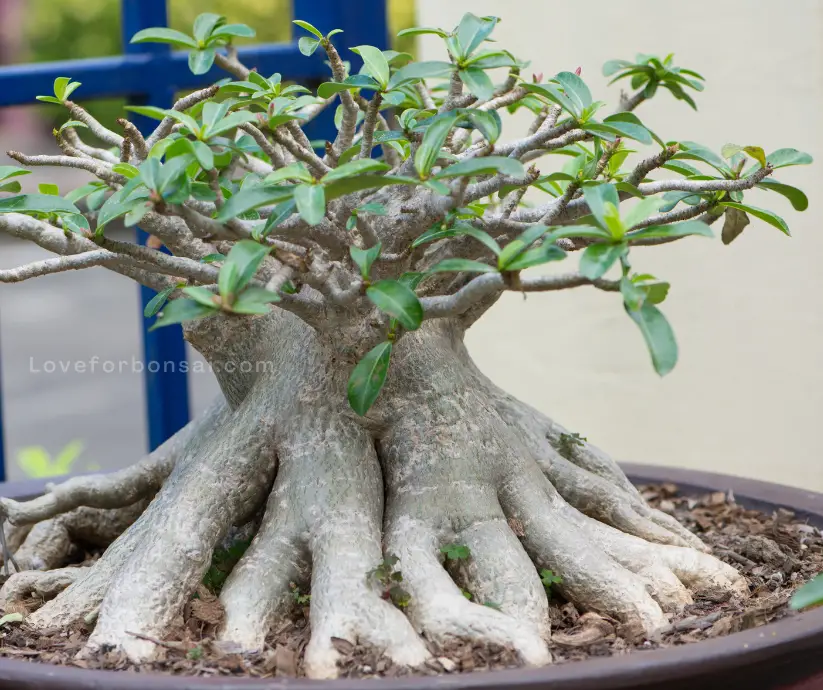Are you ready to add a touch of exotic beauty to your home or garden? Imagine a stunning little tree with striking pink or red flowers, boasting a unique caudex trunk that’s sure to turn heads. That’s the Desert Rose bonsai tree, also known as Adenium obesum.
But don’t be intimidated by its exotic nature – with a little knowledge and care, anyone can successfully grow and care for this unique plant.
In this guide, we will take you step by step through the process of growing and caring for a Desert Rose bonsai, from choosing the perfect location and watering techniques to pruning and propagation.
Get ready to embark on a journey of beauty, growth, and connection with nature as we explore the world of Desert Rose bonsai.
What is a Desert Rose bonsai?
A Desert Rose bonsai is a small tree that has been cultivated to resemble the larger Desert Rose plant. The Desert Rose is native to Africa and the Arabian Peninsula and is known for its distinctive swollen base, called a caudex.
This caudex stores water, allowing the plant to survive long periods of drought. The Desert Rose plant also produces beautiful flowers in shades of pink, red, and white.
Why grow Desert Rose Bonsai?
There are several reasons why you might want to grow a Desert Rose bonsai. Firstly, it’s an attractive plant that can make a great addition to your indoor or outdoor space.
The Desert Rose bonsai is also relatively easy to care for and can be a good choice for beginners. Additionally, growing bonsai trees can be a therapeutic hobby that helps reduce stress and improve mental well-being.
How to grow a Desert Rose plant bonsai

Growing a Desert Rose bonsai requires some patience and care, but it’s not overly difficult. Here’s what you’ll need to do:
Step 1: Choose the right container
The first step in growing a Desert Rose bonsai is to choose the right container. The container should be shallow and have drainage holes to prevent water from accumulating at the roots. You can also use a bonsai pot, which is specifically designed for growing bonsai trees.
Step 2: Select the right soil:
The soil you use for your Desert Rose bonsai should be well-draining and have good aeration. You can use a mix of perlite, sand, and peat moss to create a suitable soil mixture. Alternatively, you can purchase pre-mixed bonsai soil.
Step 3: Plant the Desert Rose:
Once you have the container and soil ready, it’s time to plant your Desert Rose bonsai. Place the plant in the container, making sure that the roots are evenly spread out. Cover the roots with soil and water thoroughly.
Step 4: Provide adequate sunlight
After growing Adenium for many years I have learned that the location of your Desert Rose bonsai is critical to its growth and development. The plant loves sunshine, so it is essential to place it in a bright spot.
The best spot to place your Desert Rose bonsai is near a south-facing window where it can get six to eight hours of direct sunlight. This will ensure that your bonsai will grow healthy and strong.
Step 5: Water the Desert Rose bonsai
Watering your Desert Rose bonsai tree is crucial to its health. Unlike other bonsai plants, the Desert Rose requires less water. The caudex of the Desert Rose stores water, so the plant can survive short periods of drought.
Water your Desert Rose plant thoroughly once the top inch of soil is dry. Make sure you do not overwater the plant as it can lead to root rot.
Always check the soil’s moisture level before watering to ensure that you are not overwatering your bonsai.
Step 6: Fertilize the bonsai tree:
Feed your Desert Rose bonsai with a slow-release fertilizer that is high in phosphorus and potassium, and low in nitrogen. Nitrogen promotes foliage growth, which is not ideal for Desert Rose bonsai, which needs to focus on flowering.
Apply the fertilizer twice a month during the growing season, which is from late spring to early fall. Each bonsai is unique and may require different care based on its location and size. So, it’s essential to monitor your plant closely and adjust your care routine accordingly.

Step 7: Prune and shape the Desert Rose bonsai:
Pruning is an essential aspect of caring for a Desert Rose bonsai tree, as it helps to maintain its shape and promote healthy growth.
The best time to prune your Desert Rose bonsai is in early spring, just before new growth begins. Use sharp, clean pruning shears to cut just above a node or bud, and be sure to remove any dead or diseased branches as well.
Avoid cutting too much at once, as this can cause stress to the tree and delay its growth. Instead, make small, precise cuts and step back frequently to assess the overall shape and balance of the tree.
Wiring a Desert Rose plant bonsai:
Wiring is a useful technique for shaping your Desert Rose bonsai tree, but always do it with care to avoid damaging the delicate branches.
Use high-quality bonsai wire and follow proper wiring techniques, making sure not to wrap the wire too tightly or leave it on for too long.
Avoid wiring during the winter months, as the tree is less able to heal and may be more susceptible to damage. Instead, wire during the growing season, when the tree is actively producing new growth and can better handle the stress of being wired.
Styling a Desert Rose bonsai tree:
The most rewarding part of growing Desert Rose bonsai tre is styling this unique and beautiful species. The key here is to work with the natural shape and growth patterns of the tree, rather than trying to force it into a particular form.
Choose a style that suits the tree’s natural characteristics. For example, the Desert Rose’s thick, twisting branches lend themselves well to informal upright or slanting styles, while its colorful flowers can be emphasized in a semi-cascade or cascade style.
When to Repot A Desert Rose Plant Bonsai:
As your Desert Rose bonsai grows, it will eventually outgrow its container and need to be repotted. Repotting should be done every 2-3 years, or when the roots have filled the container. The best time to repot is in the spring when the plant is actively growing.
To repot your Desert Rose bonsai, gently remove the tree from the container and trim back any overly long roots. Place the tree in a new container with fresh soil, and water thoroughly. You can also prune back the top growth of the tree at this time to maintain its size and shape.
Propagation:
If you want to grow additional Desert Rose bonsai trees, you can propagate the plant through cuttings. To do this, take a cutting of the Desert Rose plant in the spring or summer, making sure that it includes a caudex. Dip the cut end of the cutting in rooting hormone and plant it in a container with well-draining soil. Keep the soil moist and place the container in a warm, sunny location. The cutting should root within a few weeks.
How often should I water my Desert Rose bonsai?
As with any bonsai, the watering needs of a Desert Rose depend on several factors, including the size of the tree, the humidity levels in your environment, and the type of soil you’re using.
However, as a general rule, you should water your Desert Rose bonsai when the top inch of soil feels dry to the touch. Be sure not to overwater, as this can lead to root rot.
Can I grow my Desert Rose bonsai indoors?
Yes, Desert Rose bonsai trees can be grown indoors, but they need plenty of bright, indirect sunlight to thrive. Place your tree near a window that receives plenty of sunlight, or consider using artificial grow lights.
When should I prune my Desert Rose bonsai?
The best time to prune your Desert Rose bonsai is in early spring, just before new growth begins. This will help promote healthy growth and prevent the tree from becoming too leggy.
Be sure to use sharp, clean pruning shears and cut just above a node or bud.
How do I propagate my Desert Rose bonsai?
Propagation of a Desert Rose bonsai can be done through stem cuttings or seeds. Stem cuttings should be taken from healthy, mature branches and planted in well-draining soil. Seeds should be planted in a seed-starting mix and kept moist until they germinate.
Propagation can take several weeks or even months, so be patient and keep your new plants well-cared for.
Can I wire my Desert Rose bonsai to shape it?
Yes, wiring can be a useful technique for shaping your Desert Rose bonsai tree. However, care should be taken not to damage the delicate branches, and wires should be removed after a few months to prevent them from cutting into the bark.
Be sure to use high-quality bonsai wire and follow proper wiring techniques to achieve the desired shape without harming your tree.
Conclusion:
Congratulations, you’ve made it to the end of our guide on growing and caring for a Desert Rose bonsai tree! We hope that you’ve found this information useful and that it’s inspired you to take the leap and start your own little tree. Remember, growing a bonsai is a journey, and it takes time, patience, and care. But the reward is a stunning little tree that brings joy and beauty to your space.
If you’ve found this guide helpful, we encourage you to share it with your friends and family who might also be interested in growing a Desert Rose bonsai. And don’t forget to explore more articles on this site for tips and inspiration on all things gardening and plant care.
Finally, we want to encourage you to take action. Get out there and start growing your own Desert Rose bonsai tree! With the knowledge and techniques you’ve learned here, you’re well on your way to success.
